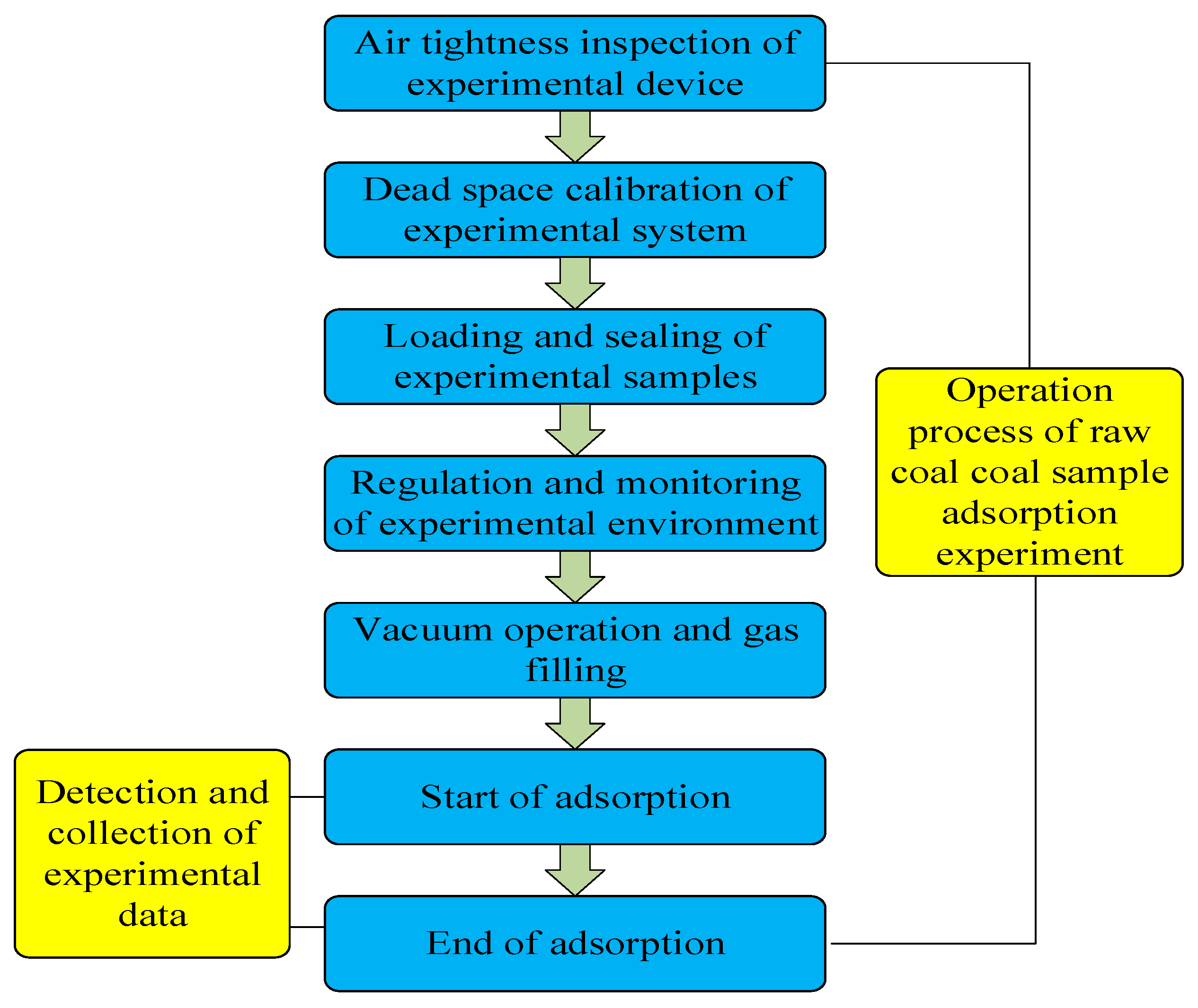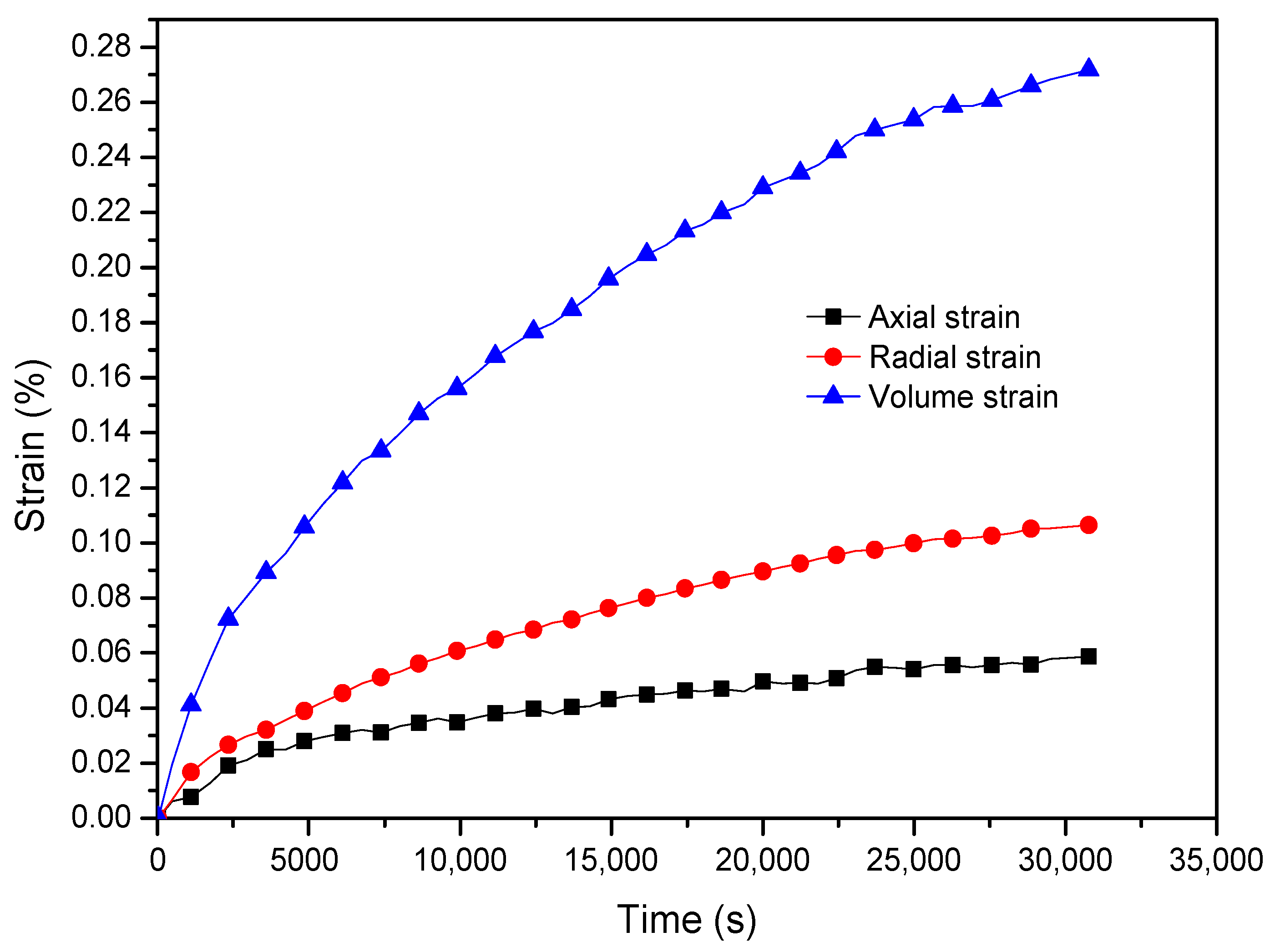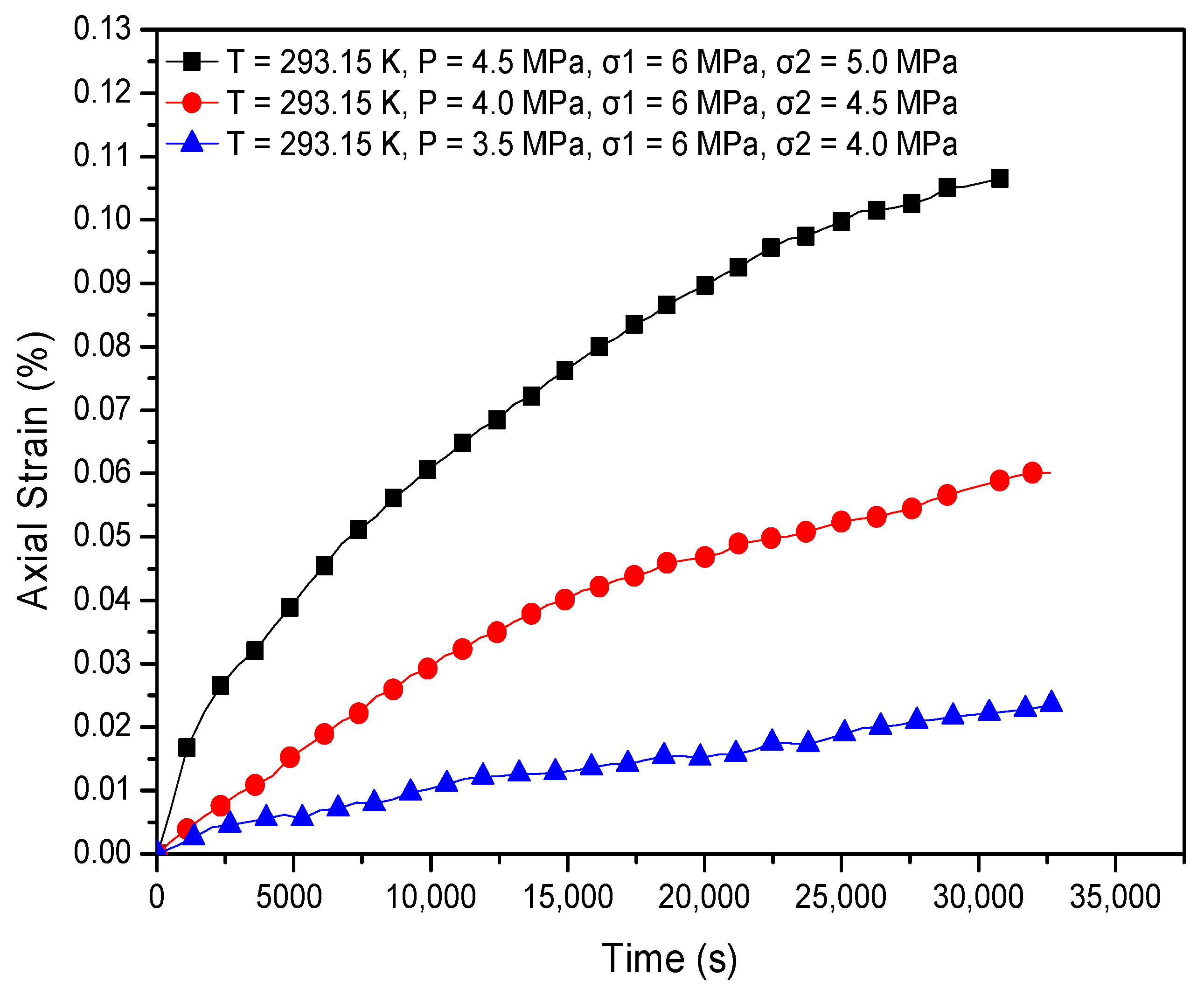Experimental Investigation on Strain Changes during CO2 Adsorption of Raw Coal Sample: Temperature and Effective Stress
Abstract
:1. Introduction
2. Samples and Experimental Process
2.1. Samples
2.2. Experimental Equipment and Procedures
3. Results and Discussion
3.1. Variation Characteristics of Adsorption Strain of Raw Coal Samples during CO2 Adsorption
3.2. Effect of Axial Effective Stress and Temperature Conditions on Strain Variation of Raw Coal Samples during CO2 Adsorption
3.3. Discussion
4. Conclusions
Author Contributions
Funding
Institutional Review Board Statement
Informed Consent Statement
Data Availability Statement
Conflicts of Interest
References
- Lacis, A.A.; Schmidt, G.A.; Rind, D.; Ruedy, R.A. Atmospheric CO2: Principal Control Knob Governing Earth’s Temperature. Science 2010, 330, 356–359. [Google Scholar] [CrossRef] [PubMed] [Green Version]
- Hamza, A.; Hussein, I.A.; Al-Marri, M.J.; Mahmoud, M.; Shawabkeh, R.; Aparicio, S. CO2 enhanced gas recovery and sequestration in depleted gas reservoirs: A review. J. Pet. Sci. Eng. 2021, 196, 107685. [Google Scholar] [CrossRef]
- Masoudian, M.S. Multiphysics of carbon dioxide sequestration in coalbeds: A review with a focus on geomechanical characteristics of coal. J. Rock. Mech. Geotech. Eng. 2016, 8, 93–112. [Google Scholar] [CrossRef] [Green Version]
- Garnier, C.; Finqueneisel, G.; Zimny, T.; Pokryszka, Z.; Lafortune, S.; Défossez, P.D.C.; Gaucher, E.C. Selection of coals of different maturities for CO2 Storage by modelling of CH4 and CO2 adsorption isotherms. Int. J. Coal Geol. 2011, 87, 80–86. [Google Scholar] [CrossRef] [Green Version]
- Ranathunga, A.S.; Perera, M.S.A.; Ranjith, P.G.; Wei, C.H. An experimental investigation of applicability of CO2 enhanced coal bed methane recovery to low rank coal. Fuel 2017, 189 (Suppl. SC), 391–399. [Google Scholar] [CrossRef]
- Wang, S.; Hu, Y.; Yang, X.; Liu, G.; He, Y. Examination of adsorption behaviors of carbon dioxide and methane in oxidized coal seams. Fuel 2020, 273, 117599. [Google Scholar] [CrossRef]
- Prusty, B.K. Sorption of methane and CO2 for enhanced coalbed methane recovery and carbon dioxide sequestration. J. Nat. Gas Chem. 2008, 17, 29–38. [Google Scholar] [CrossRef]
- Vishal, V.; Singh, L.; Pradhan, S.P.; Singh, T.N.; Ranjith, P.G. Numerical modeling of Gondwana coal seams in India as coalbed methane reservoirs substituted for carbon dioxide sequestration. Energy 2013, 49, 384–394. [Google Scholar] [CrossRef]
- Wei, X.; Massarotto, P.; Wang, G.; Rudolph, V.; Golding, S.D. CO2 sequestration in coals and enhanced coalbed methane recovery: New numerical approach. Fuel 2010, 89, 1110–1118. [Google Scholar] [CrossRef]
- Gentzis, T. Subsurface sequestration of carbon dioxide—An overview from an Alberta (Canada) perspective. Int. J. Coal Geol. 2000, 43, 287–305. [Google Scholar] [CrossRef]
- Wei, G.; Wen, H.; Deng, J.; Ma, L.; Li, Z.; Lei, C.; Fan, S.; Liu, Y. Liquid CO2 injection to enhance coalbed methane recovery: An experiment and in-situ application test. Fuel 2021, 284, 119043. [Google Scholar] [CrossRef]
- Zhang, X.; Ranjith, P.G.; Lu, Y.; Ranathunga, A.S. Experimental investigation of the influence of CO2 and water adsorption on mechanics of coal under confining pressure. Int. J. Coal Geol. 2019, 209, 117–129. [Google Scholar] [CrossRef]
- Zhang, X.; Ranjith, P.G. Experimental investigation of effects of CO2 injection on enhanced methane recovery in coal seam reservoirs. J. Co2 Util. 2019, 33, 394–404. [Google Scholar] [CrossRef]
- Li, Z.; Wei, G.; Liang, R.; Shi, P.; Wen, H.; Zhou, W. LCO2-ECBM technology for preventing coal and gas outburst: Integrated effect of permeability improvement and gas displacement. Fuel 2021, 285, 119219. [Google Scholar] [CrossRef]
- Bachu, S.; Bonijoly, D.; Bradshaw, J.; Burruss, R.; Holloway, S.; Christensen, N.P.; Mathiassen, O.M. CO2 storage capacity estimation: Methodology and gaps. Int. J. Greenh Gas Control 2007, 1, 430–443. [Google Scholar] [CrossRef] [Green Version]
- Wang, K.; Du, F.; Wang, G. Investigation of gas pressure and temperature effects on the permeability and steady-state time of chinese anthracite coal: An experimental study. J. Nat. Gas Sci. Eng. 2017, 40, 179–188. [Google Scholar] [CrossRef]
- Liu, Z.; Cheng, Y.; Wang, Y.; Wang, L.; Li, W. Experimental investigation of CO2 injection into coal seam reservoir at in-situ stress conditions for enhanced coalbed methane recovery. Fuel 2019, 236, 709–716. [Google Scholar] [CrossRef]
- Ranathunga, A.S.; Perera, M.S.A.; Ranjith, P.G.; Bui, H. Super-critical CO2 saturation-induced mechanical property alterations in low rank coal: An experimental study. J. Supercrit. Fluids 2016, 109, 134–140. [Google Scholar] [CrossRef]
- Niu, Q.; Cao, L.; Sang, S.; Zhou, X.; Wang, W.; Yuan, W.; Ji, Z.; Wang, H.; Nie, Y. Study on the anisotropic permeability in different rank coals under influences of supercritical CO2 adsorption and effective stress and its enlightenment for CO2 enhance coalbed methane recovery. Fuel 2020, 262, 116515. [Google Scholar] [CrossRef]
- Wang, K.; Zang, J.; Wang, G.; Zhou, A. Anisotropic permeability evolution of coal with effective stress variation and gas sorption: Model development and analysis. Int. J. Coal Geol. 2014, 130, 53–65. [Google Scholar] [CrossRef]
- Wang, D.; Lv, R.; Wei, J.; Zhang, P.; Yu, C.; Yao, B. An experimental study of the anisotropic permeability rule of coal containing gas. J. Nat. Gas Sci. Eng. 2018, 53, 67–73. [Google Scholar] [CrossRef]
- Zang, J.; Wang, K. A numerical model for simulating single-phase gas flow in anisotropic coal. J. Nat. Gas Sci. Eng. 2016, 28, 153–172. [Google Scholar] [CrossRef]
- Lu, J.; Yin, G.; Zhang, D.; Gao, H.; Li, C.; Li, M. True triaxial strength and failure characteristics of cubic coal and sandstone under different loading paths. Int. J. Rock. Mech. Min. 2020, 135, 104439. [Google Scholar] [CrossRef]
- Guan, C.; Liu, S.; Li, C.; Wang, Y.; Zhao, Y. The temperature effect on the methane and CO2 adsorption capacities of Illinois coal. Fuel 2018, 211, 241–250. [Google Scholar] [CrossRef]
- Zhou, Y.; Li, Z.; Zhang, R.; Wang, G.; Yu, H.; Sun, G.; Chen, L. CO2 injection in coal: Advantages and influences of temperature and pressure. Fuel 2019, 236, 493–500. [Google Scholar] [CrossRef]
- Liu, C.; Sang, S.; Fan, X.; Zhang, K.; Song, F.; Cui, X.; Wang, H. Influences of pressures and temperatures on pore structures of different rank coals during CO2 geological storage process. Fuel 2020, 259, 116273. [Google Scholar] [CrossRef]
- Du, X.; Cheng, Y.; Liu, Z.; Yin, H.; Wu, T.; Huo, L.; Shu, C. CO2 and CH4 adsorption on different rank coals: A thermodynamics study of surface potential, Gibbs free energy change and entropy loss. Fuel 2021, 283, 118886. [Google Scholar] [CrossRef]
- Hol, S.; Peach, C.J.; Spiers, C.J. Applied stress reduces the CO2 sorption capacity of coal. Int. J. Coal Geol. 2011, 85, 128–142. [Google Scholar] [CrossRef]








| Sample Label | Mad/% | Vdaf/% | Ad/% | Fcd/% |
|---|---|---|---|---|
| #1 | 0.55 | 24 | 12.12 | 63.33 |
| #2 | 0.55 | 24.08 | 12.04 | 63.33 |
| #3 | 0.54 | 24.46 | 12.25 | 62.75 |
| #4 | 0.56 | 23.76 | 12.29 | 63.39 |
| Sample Label | Weight/g | Length/mm | Diameter/mm | Volume/cm3 | Density/g/cm3 | Permeability/md |
|---|---|---|---|---|---|---|
| # | 247.80 | 96.70 | 49.62 | 186.90 | 1.33 | 0.0174 |
Publisher’s Note: MDPI stays neutral with regard to jurisdictional claims in published maps and institutional affiliations. |
© 2021 by the authors. Licensee MDPI, Basel, Switzerland. This article is an open access article distributed under the terms and conditions of the Creative Commons Attribution (CC BY) license (http://creativecommons.org/licenses/by/4.0/).
Share and Cite
Wang, K.; Fu, Q.; Zhang, X.; Jia, H. Experimental Investigation on Strain Changes during CO2 Adsorption of Raw Coal Sample: Temperature and Effective Stress. Energies 2021, 14, 717. https://doi.org/10.3390/en14030717
Wang K, Fu Q, Zhang X, Jia H. Experimental Investigation on Strain Changes during CO2 Adsorption of Raw Coal Sample: Temperature and Effective Stress. Energies. 2021; 14(3):717. https://doi.org/10.3390/en14030717
Chicago/Turabian StyleWang, Kai, Qichao Fu, Xiang Zhang, and Hengyi Jia. 2021. "Experimental Investigation on Strain Changes during CO2 Adsorption of Raw Coal Sample: Temperature and Effective Stress" Energies 14, no. 3: 717. https://doi.org/10.3390/en14030717






